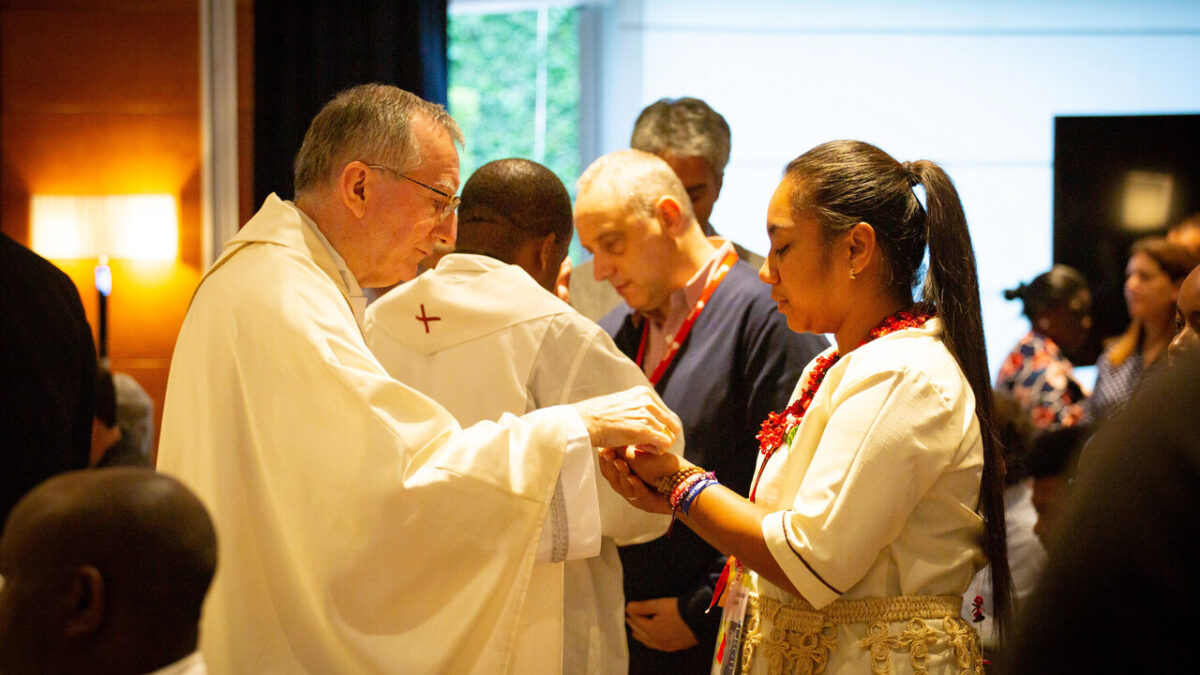Corpus Christi: Becoming the Body of Christ

At Corpus Christi Francis Stewart from our Theology team reflects on the Eucharist and how we are what we eat.
The feast of Corpus Christi, or The Solemnity of the Most Holy Body and Blood of Christ, was a local celebration in Liège (now Belgium) until 1230, when St Julienne de Cornillon brought to Pope Urban IV the news of a vision she had of a bleeding Eucharistic host. From then on it became a celebration for the whole Church of the real presence of Christ’s body and blood in the Eucharist.
Transformative food
Within this fundamental Catholic belief is a radical claim. God gives himself to us, enters the humdrum of our lives, through bread and wine, the most well-known of foodstuffs. Like manna was for the ancient Israelites, the body and blood of Christ is for Catholics a means of growing in the life God wants us to live.
In the Liturgy of the Eucharist, we practice thanksgiving for the fruits of the earth and work of human hands. We share a sign of peace with one another. We feast together, and hopefully those less mobile in the congregation are the first to receive the host. When Mass is ended, alongside those who take communion to the sick, we are all sent forth into the wider community to “glorify the Lord by our lives”. We are modelling the priorities of God’s kingdom. The first shall be last and the last shall be first.
The Eucharist transforms us – we receive Christ’s body as a gathered community so that we can become Christ’s body more fully. But it doesn’t always feel like that. I often experience Holy Communion not as a modelling of a world that’s healed but a framing of a world that’s broken. The queue of quietly shuffling feet and occasional children’s cries could be the millions queuing for emergency food today in East Africa and other parts of the world.
Pray for all those who are struggling to get enough food in our world today.
You are what you eat
When we eat, we absorb food and transform it into our own bodies. In an article for the Tablet last year, Alban McCoy reminded readers that, in the Eucharist, it is us who are being transformed into what we eat. We become the body of Christ.
This points to a wider social reality. For better or for worse, depending on the meal, “we are what we eat”. But this is more than biological. Whenever we eat, we become part of a complex network of fruits of the earth and work of human hands.
A good meal brings us together with those around the table, as well as the cooks and the growers. Frequently, food is a source of cultural memory and common identity. The theologian Angel F. Méndez Montoya OP writes that the traditional Mexican dish, Molli, still today holds the memory of the Aztec civilization from before the Americas were conquered. It was traditionally eaten with corn which, according to Aztec cosmology, is the substance from which human beings were created by the gods.
Yet the global economy connects our eating with others in less feel-good ways. Global supply chains in food are predominantly geared towards monocultural farming for the purposes of export. This serves diets and economies stemming from industrialisation and colonialism, and leaves the local people with limited choice and variety. Land is used to export wheat to feed those overseas, rather than to grow local staples to feed local people. Seeds are sold to make profit for big companies, at the expense of the seeds that smallholder farmers want to exchange among themselves and save in case floods wipe out the crop.
Stand in solidarity with small-scale farmers
Hungry for justice
I began by presenting a contrast between the Eucharist modelling a better world and the Eucharist framing a broken world, which risks leading us into thinking that it has to be one or the other. But maybe both realities are true. Maybe the Eucharist is one of those meals where you feel hungrier as you are filled. Hungrier for justice, closer to people and yet more acutely aware of those who are estranged from the table of plenty.